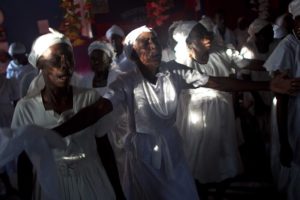by Nora Connor
In its October issue, Harper’s* revisits the zombie phenomenon–the Haitian kind, that is, not the George Romero kind. Which, come to think of it, makes it a bit of a strange Halloween selection. Journalist Hamilton Morris did his reporting pre-earthquake; the social feature most representative of Haiti’s practical difficulties is an excess of burning plastic garbage, a result of dysfunctional or nonexistent collection. It’s as if Harper’s were running a time capsule piece, giving us a brief glimpse of pre-Year Zero Haiti.
Morris’s piece is also an exercise in the policing of genre boundaries within academic and journalistic endeavors. At least since the mid-1980s, when anthropologist/ethnobotanist Wade Davis published The Serpent and the Rainbow, where there are Haitian Zombies, there are drugs. Davis took the social fact of zombification as a given and attempted to identify the chemical element in the sorcerers’ powder that makes the process, understood as magical or supernatural, “scientifically” possible. He may or may not have found it—TTX, a toxin from the organs of puffer fish that causes temporary paralysis—and gained no small amount of notoriety in the meantime. Scientists jumped on his science, anthropologists shredded his anthropology, historians disputed his history.
Davis was accused of violating the ethical standards of a number of disciplines: he paid for his drug samples, did not report the results of tests unfavorable to his preferred conclusions, participated in (enabled by his presence?) the exhuming of a child’s body, and by some lights amplified a racist narrative of Haitians as primitive and superstitious. Continue Reading →


